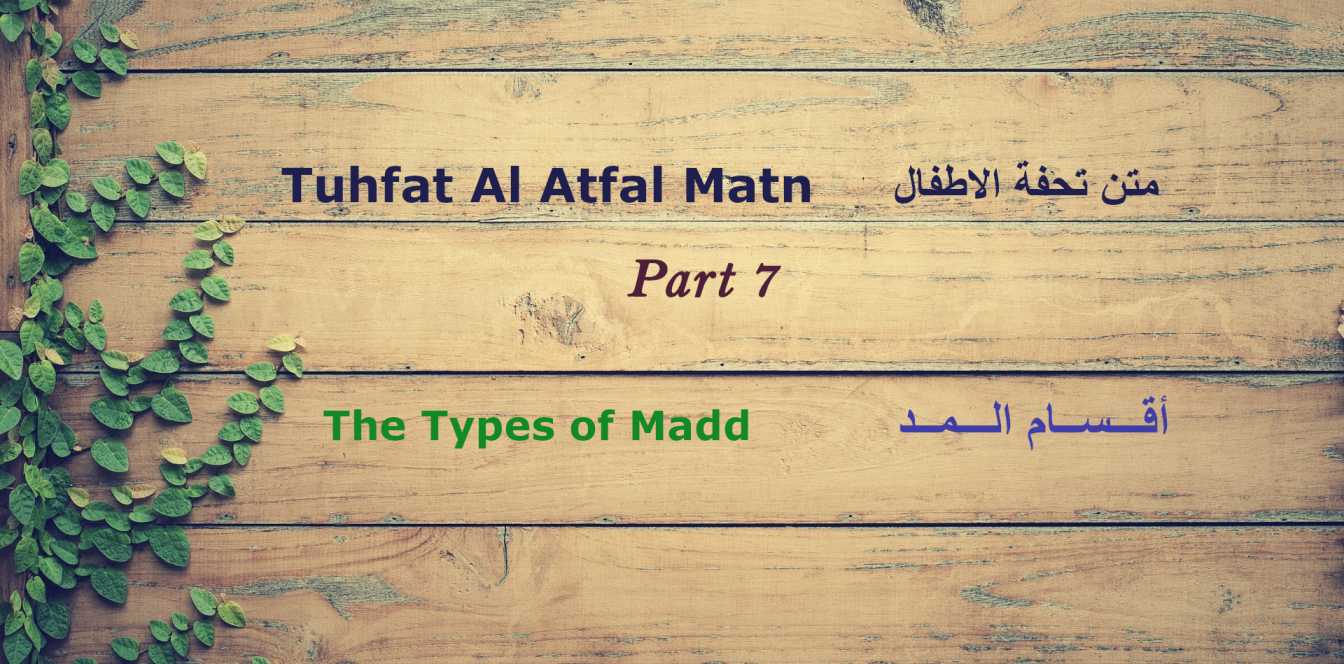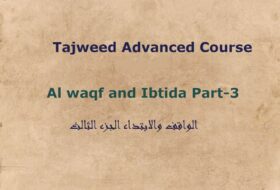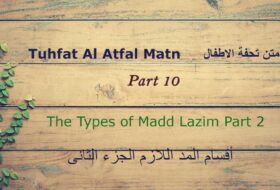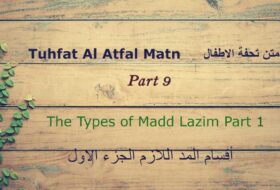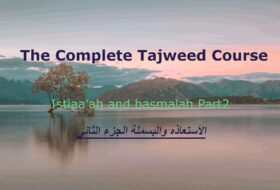The Types of Madd أقـــســام الـــمــد
See Part 1 Part 2 Part3 part4 part5
أقسام المد
وَالَمــدُّ أَصْــلِيٌّ وَفَـــرْعِيٌّ لَهُ وَسَمـَّ أَوَّلاً طَبِيِعيــــاً وَهُو
مَـا لا تَوَقُّــفَ لَـهُ عَلَــي سَبَبْ وَلا بِدُونـِهِ الحُرُوفُ تَجْتَلَــبْ
بَــلْ أَيُّ حَرْفٍ غْيرِ هَمْزٍ أَوْ سُكُونْ جَا بَعْدَ مَـدًّ فَالطَّبِيِعِيُّ يَكــُونْ
والآخَـر الفَـــرْعِيُّ مَوْقُوفٌ عَلَي سَبَبْ كَهَمْـزٍ أَوْ سُكُونٍ مُسْجَلاَ
حُــرُوفُهُ ثَـــلاثَةٌ فَعِيــــهَا مِنْ لَفْظِ وَايٍ وَهْـيَ فِي نُوحِيهَا
وَالكَســْرُ قَيْلَ اليَا وَقَبْلَ الوَاو ضَمْ شَرْطٌ وَفَتْحٌ قَبْلَ أَلْـف يُلْتَــزَمْ
وَاللَّيْــنُ مِنْــهَا اليا وَوَاوٌ سَكنَاَ إِنْ انفِتَاحٌ قَبْلَ كُــــلًّ أُعلِنَا
TEXT: 35
وَالَمــدُّ أَصْــلِيٌّ وَفَـــرْعِيٌّ لَهُ وَسَمـَّ أَوَّلاً طَبِيِعيــــاً وَهُو
VOCABULARY:
وَالَمــدُّ – the pulling, extending, lengthening (of sound)
أَصْــلِيٌّ – primary
وَفَـــرْعِيٌّ – secondary
لَهُ – َfor it i.e. for the madd
أَوَّلاً – the first
طَبِيِعيــــاً – natural
وَهُو – and it (the primary madd)
TRANSLATION:
35. And the madd is (either) primary or secondary to it, and name the first a natural (madd) and it is. . .
COMMENTARY:
Madd literally means to lengthen or extend. Technically, it means to lengthen the sound in the letters of madd or the letters of leen.
In the first line the author states that madd is of two types: primary (الأصْــلِيٌّ ) and secondary (الفَـــرْعِيٌّ ) .( He also mentions that madd aṣle is
also called madd ṭabee. Ṭabii means natural. It is named so because a person with a natural disposition will ordinarily lengthen this madd without any deficiency in its duration, nor any exaggeration in it The duration of madd ṭabee is one alif or two ḥarakat. Considering classical and contemporary works, it is sometimes difficult for the beginner to understand this duration when different technical terms are used by different authors. The following table is an attempt to simplify them:

In the right column, second line from the bottom, the letter which is read is represented by a baaʾ. Above the letter is the length of madd counted in ḥarakat and below it, its length counted in Alifs. At the same time, though, every two ḥarakāt equal one alif (counted in the first line).
The duration of qaṣr would be 1 alif, which would be equal to 2 ḥarakat: the first ḥarakah on the letter itself and the second would be the same amount of time it took to pronounce the letter of madd Thus it would also be correct to say that the duration of ṭul is 6 ḥarakat, 3 alifs or 5 alifs since they all are one and the same duration, only differing in terms of the counting system being used.
The duration between qaṣr and ṭul is known as tawassut. In the next line the author goes on to explain what madd ṭabee is.
TEXT: 36
مَـا لا تَوَقُّــفَ لَـهُ عَلَــي سَبَبْ وَلا بِدُونـِهِ الحُرُوفُ تَجْتَلَــبْ
VOCABULARY:
مَـا – that which
لا – َis not, does not
تَوَقُّــفَ – depend
سَبَبْ – cause
سَبَبْ – without it (the madd-pull)
ْتَجْتَلَــبْ– َُcannot be brought forth i.e. cannot be read.
TRANSLATION:
36. That which has no dependence on a cause, and without it (the madd-pull), these letters cannot be brought forth (cannot be read)
COMMENTARY:
Madd ṭabīʿī is that madd which does not depend on any cause/reason for it to be pulled. In reality, without lengthening the sound in the letters of madd, they cannot be read. For instance, if the alif is not pulled in قَالَ then it will be read as قَلَ The only time when the alif can be read is if the sound is pulled in it. The same will apply to the yaaʾ in قِيلَ and the waw in يَقُولُ i.e. they can only be read if a pull (madd) is made in them .
TEXT: 37
بَــلْ أَيُّ حَرْفٍ غْيرِ هَمْزٍ أَوْ سُكُونْ جَا بَعْدَ مَـدًّ فَالطَّبِيِعِيُّ يَكــُونْ
VOCABULARY:
بَــلْ – but, rather, in fact
أَيُّ – َwhichever, any
غْيرِ – besides, other than. It may be read with a fatḥah or a kasrah on the ra
هَمْزٍ – a hamzah (the letter)
جَا – comes, appears
TRANSLATION:
37. In fact, (if) any letter besides the hamzah or sukoon appears after a (letter of) madd, then the natural (madd) results. )
COMMENTARY:
In the previous line the author explains that madd ṭabīʿī is that madd which is not dependent on a cause. In this line he alludes to what those causes are: the hamzah and sukun. Thus, as long as a letter of madd is not followed by a reason (hamzah or sukun) then it will be madd ṭabii.
The word فَالطَّبِيِعِيُّ may be read with a fatḥah or a ḍammah.

TEXT: 38
والآخَـر الفَـــرْعِيُّ مَوْقُوفٌ عَلَي سَبَبْ كَهَمْـزٍ أَوْ سُكُونٍ مُسْجَلاَ
VOCABULARY:
والآخَـر – the other (madd)
مَوْقُوفٌ – dependent
ك – like
مُسْجَلاَ – ُin general
TRANSLATION:
38. And the other (madd) is the secondary, (which is) dependant on a reason like a hamzah or sukon in general (wherever it appears in the Quran).
COMMENTARY:
After explaining what madd ṭabii is, madd farʿi is elaborated upon. Technically, it is that madd, which is pulled longer than the madd ṭabii due to a cause i.e. when the letter of madd is followed by a hamzah or (letter with) a sukon.
By مُسْجَلاَ the author indicates that throughout the Quran, wherever the letter of madd is followed by a hamzah or sukun (a cause), then madd farʿi takes place.
The duration of madd farʿi will depend on what type of madd farʿi it is. If the letter of madd is followed by a hamzah, it will either be in the same word as the letter of madd or a different word. The first would be muttaṣil and the latter, munfaṣil. If the letter of madd is followed by a sukun, it is either permanent or temporary. The first is called lazim and the latter ʿariḍ. Their durations will be discussed in the next chapter in more detail.
TEXT: 39
حُــرُوفُهُ ثَـــلاثَةٌ فَعِيــــهَا مِنْ لَفْظِ وَايٍ وَهْـيَ فِي نُوحِيهَا
VOCABULARY:
فَعِيــــهَا – so grasp/memorise/remember them (the letters of madd)
لَفْظِ – word – م
وَايٍ – the word is originally وَايٍ , which means to promise. The hamzah is changed to and alif, thus becoming a combination which holds all the letters of madd.
وَهْـيَ – and they (these letters of madd)
نُوحِيهَا – an example in which all the letters of madd can be found
TRANSLATION:
39. Its (the madd’s) letters are three, so remember them from the word وَايٍ and they are (found) in (the example) نُوحِيهَا
COMMENTARY:
In the next three lines Jamzuri explains the letters of madd. They are three which can easily be remembered in the combination وَايٍ waw, alif and yaʾ.
He also presents an example which holds all three letters of madd, نُوحِيهَا It is important to note how these letters of madd appear in this example; they are all sakin, and are preceded by a ḥarakah
which conforms/agrees with the letter of madd i.e. a ḍammah before a waw, a kasrah before a yaaʾ, and a fatḥah before an alif. He explains this further in the next line.
TEXT: 40
وَالكَســْرُ قَيْلَ اليَا وَقَبْلَ الوَاو ضَمْ شَرْطٌ وَفَتْحٌ قَبْلَ أَلْـف يُلْتَــزَمْ
VOCABULARY:
وَالكَســْرُ – the kasrah
ضَمْ – a ḍammah
شَرْطٌ – condition, requirement, prerequisite
وَفَتْحٌ – fatḥah
ٍْأَلْـف – َan alif
يُلْتَــزَمْ– necessary
TRANSLATION:
40. And a kasrah before the yaʾ, and before the waw a ḍammah is a requirement, and a fatḥah before the alif is necessary
COMMENTARY:
The requirements for the letters of madd are explained in this line. The wشw should be preceded by a ḍammah and the yaaʾ should be preceded by a kasrah. An important point which is not explicitly explained in the text, but is alluded to by the author in the example نُوحِيهَا is that they should also be sشkin.
Therefore, if the wāw and yā` are not sākin, they will not be lettersof madd e.g. ُ يُوسْوس In this example they are mutaḥarrikah.
And if they are sakin but preceded by a fatḥah, then too, they won’t be letters of madd but instead letters of leen e.g. ِ شَىء This is further explained in the next line .
An alif will always be preceded by a fatḥah, therefore he states that a fatḥah appearing before an alif is necessary. An alif is always considered as sākin even though the sukūn is not written on it.
TEXT: 41
وَاللَّيْــنُ مِنْــهَا اليا وَوَاوٌ سَكنَاَ إِنْ انفِتَاحٌ قَبْلَ كُــــلًّ أُعلِنَا
VOCABULARY:
وَاللَّيْــنُ – the letters of) līn
مِنْــهَا – from them (these letters; the alif, waaw and yaa)
سَكنَاَ– ُthe two (waw and ya) are sakin. It may also be read as سَكنَاَ
إِنْ – when
انفِتَاحٌ – openness, referring to a fatḥah
كُــــلًّ – each of them, all (of them)i.e. the waaw and the yaa
أُعلِنَا– is announced
TRANSLATION:
41. And leen from them (these three letters) is the yaʾ and waw, carrying a sukon, if a fatḥah before each is announced
COMMENTARY:
If there is a fatḥah before the waw sakinah or yaʾ sakinah then they will be letters of leen and not letters of madd.
learn-ten-qiraat-online
tafseer-course-online
benefits-of-reading-quran

